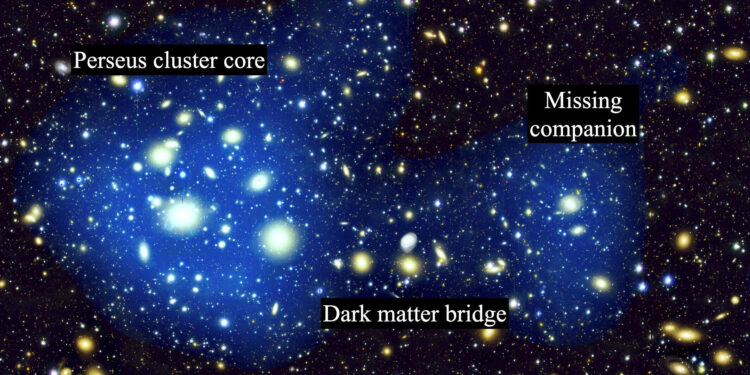Dark matter in the Persée cluster. The distribution of dark matter (in blue) is superimposed on an image taken by Hyper Sprime-Cam on the Subaru telescope. The newly detected subclusive located near the Galaxy NGC 1264 is around 1.4 million light years to the west (right side of the image) of the central Galaxy of Perseus, NGC 1275. A small bridge connects the two structures. Credit: Hyeonghan et al
An international team of astronomers has resolved one of the longtime cosmic mysteries by discovering direct evidence of a massive object and long lost which collided with the pile of Perseus. Using high resolution data from the Subaru telescope, the researchers managed to draw the rest of this old merger through the distribution of dark matter.
Galaxies clusters, made up of thousands of galaxies linked together by gravity, are among the most massive structures in the universe. They grow up through energetic mergers – some of the most powerful events from the Big Bang.
Located at around 240 million light years from the earth, the Perseus cluster has a mass equivalent to 600 billions of suns (called solar masses). For decades, astronomers thought it had long settled in a stable and post-fusion state. His apparent lack of signs of Clear Fusion earned him the reputation of being “the example of Manuel” of a relaxed cluster.
However, the progress of observation techniques has enabled researchers to penetrate more deep into its structure, discovering subtle but convincing evidence of past disruption. This raises a fundamental mystery: if there are signs of a collision, where is the object that has collided with it?
To resolve the mystery, the team analyzed the hyper-suprime-cam archive data on the Subaru telescope. Gravitational lenses – A phenomenon where massive objects fold the light of background galaxies – served as a powerful tool to map invisible dark matter.
Thanks to this technique, the researchers identified a massive agitation of dark matter, weighing around 200 billions of solar masses, located about 1.4 million light years west of the cluster nucleus. Remarkably, this structure is linked to the heart of the cluster persemed by a “bridge of light black matter but statistically significant, providing direct evidence of the gravitational interaction between them.
The digital simulations carried out by the team suggest that this black matter sub-structure collided with the pile of Perseus about five billion years ago. The remains of this collision still shape the current structure of the cluster.
“This is the missing play we are looking for,” explains Dr. James Jee, corresponding author of the study published in Natural astronomy. “All strange forms and swirling gas observed in the Persée cluster now make sense in the context of a major fusion.”
“It took courage to challenge the dominant consensus, but the simulation results from our employees and recent observations of the Euclid and Xrism space telescopes strongly support our results,” continues Dr. Hyeonghan Kim, the first author of the study.
“This breakthrough was made possible by combining deep imaging data from the Subaru telescope with advanced gravitational lenses techniques that we have developed – according to the power of the lens to reveal the hidden dynamics of the most massive structures of the universe,” explains Dr. Jee.
More information:
Kim Hyeonghan et al, direct proof of a major merger in the Perseus cluster, Natural astronomy (2025). DOI: 10.1038 / S41550-025-02530-W
Supplied by the Subaru telescope
Quote: Astronomers discover the missing merger companion and the bridge of dark matter in the Persée cluster (2025, April 21) recovered on April 21, 2025
This document is subject to copyright. In addition to any fair program for private or research purposes, no part can be reproduced without written authorization. The content is provided only for information purposes.



